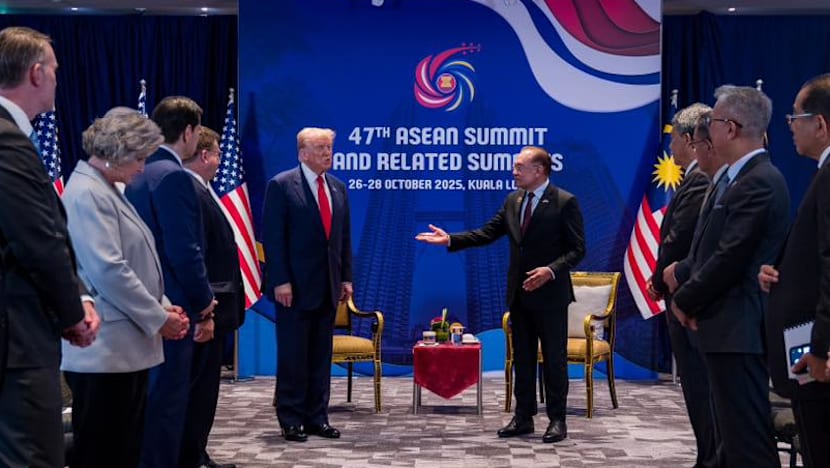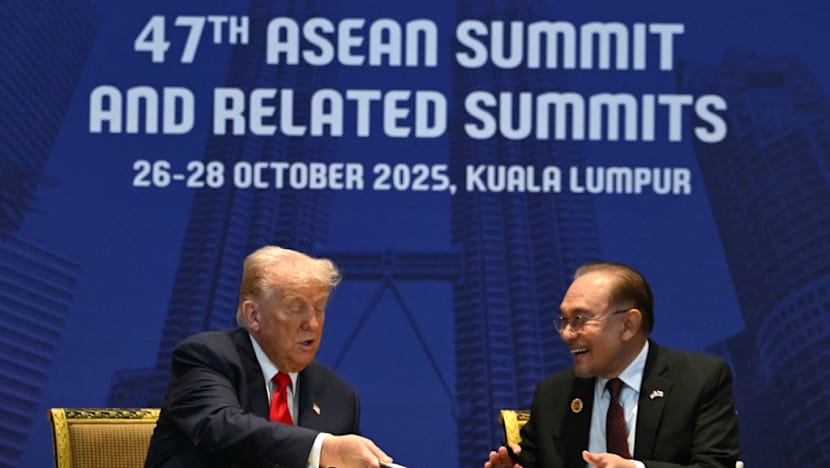Commentary: Critics and supporters of US-Malaysia trade deal only get it half right
Amid expectations of an upcoming Cabinet reshuffle in Malaysia, the most crucial change is that the trade minister will definitely be replaced, says political analyst James Chai.

US President Donald Trump and Malaysia Prime Minister Anwar Ibrahim are seen here during the 47th ASEAN Summit and Related Summits in Kuala Lumpur on Oct 26, 2025. (Photo: Facebook/Tengku Zafrul)

This audio is generated by an AI tool.
KUALA LUMPUR: To say that the United States-Malaysia trade agreement infringes on Malaysia’s sovereignty may be an overstatement; to say it does not concern sovereignty at all lacks intellectual honesty.
Contrary to the celebratory mood of the ASEAN Summit in October, where Malaysian Prime Minister Anwar Ibrahim and US President Donald Trump signed the deal, the fine print of the Agreement on Reciprocal Trade reflected legitimate concerns of Malaysia being absorbed into the US’ orbit.
The Trump administration’s strategy is revealed in this agreement. And Southeast Asian countries with trade deficits with the US can reasonably presume that this constitutes the framework across the region.
There are three parts, which most clauses tie back to, that countries should pay attention to.
First, Malaysia will be required to enforce against potential violation of US tariffs and trade measures, as seen in Articles 2.12(1), 4.1 and 5.3(2). This is somewhat expected: The Trump administration has accused Southeast Asian countries of “origin-washing”, re-exporting products from China with their origin concealed to evade tariffs.
Second, the US expects Malaysia to implement domestic laws and policies to align with specific US export controls, sanctions screening and other measures deemed relevant to US national and economic security. Complementary actions that have “equivalent restrictive effect” are also expected (Article 5.1 and 5.2).
Third, there is a catch-all broad alignment reflected in Article 5.3(3), that warns against Malaysia taking other trade actions that “jeopardises essential US interest”. Specifically, Malaysia needs to consult the US before entering new digital trade agreements with other countries and gives the US broad enforcement reserves for its economic and national security (Article 3.3 and 7.4).
WORSE CONSEQUENCES WITHOUT A BAD DEAL?
Malaysia seems to have entered a poor deal, when compared to Cambodia which secured the same tariff rate of 19 per cent with a deal signed on the same day. Cambodia’s deal makes specific mention of actions being “consistent with Cambodia’s sovereign interest”.
For Thailand and Vietnam, which have yet to finalise their trade agreements with the US, there is so far no mention of formal alignments in the key terms published in joint statements.
Critics argued that the US-Malaysia deal infringes on Malaysia’s sovereignty, even calling this a new form of “imperialism”. The basis of this criticism is that, unlike other free trade agreements signed before, this deal imposes legal considerations of US interests. It also adds a mediating element of consulting the US, removing Malaysia’s sole agency in deciding what is best for itself.
The Minister of International Trade and Investment, Tengku Zafrul Aziz, defended the US-Malaysia deal, calling it the “best possible outcome for Malaysia”. He characterised the deal’s alignment coverage as narrow, covering only “shared” concerns, and thus retaining Malaysia’s sovereignty. He also said that the exit clause in the deal was a backstop in case Malaysia gets pushed into a corner.
While it was likely a political figure of speech, Mr Zafrul concluded with one point that is a closer reflection of reality: Malaysia had little choice but to risk a higher tariff amount. ‘[E]ven 100 per cent,’ the minister quipped.
STILL ROOM FOR SELF-PRESERVATION
Both sides carry partial truths. The reality is that what little space Malaysia had to manoeuvre is shrinking and that raises the stakes of its actions.
The criticisms of infringed sovereignty see the pessimistic future as a virtual certainty, even though Malaysia arguably still retains some agency, via domestic legislations, alignment diversification, strategic silence or other self-preserving methods. For instance, domestic legislation to align with US interest could be delayed, postponed or diluted through legal language, or Malaysia could seek alignment with other blocs, which has the effect of balancing against US interest.
It depends on US appetite for monitoring and enforcement. As long as the US does not knock on Malaysia’s door, it could still cruise along. An infringement on sovereignty has not happened yet, though even previously-innocent deals like ASEAN’s upcoming Digital Economy Framework Agreement will be questioned about whether it needs the US’ assent or knowledge.

On the other hand, Mr Zafrul’s defence that the deal is narrow and Malaysia has a backstop is also more theoretical than real. Malaysia likely could not afford to exit such a high-stakes agreement without severe repercussions.
Further, if it were true that Malaysia did not have a real choice to enter this agreement, it follows that it will also not have a real choice to back out. The US, after all, is Malaysia’s largest trading partner and the world’s largest economy, and Malaysia is highly dependent on the US for its chips exports.
EXPANDING SKILLSET OF A TRADE MINISTER
What the US-Malaysia trade deal has done is give the US a formal, legal way to create alignment and act against non-alignment. This will likely be the same for most Southeast Asian countries wanting a lower tariff rate.
Countries that signed with the US now have fewer options and more red lines, face higher scrutiny of actions, and confront a persistent threat of repercussions from their largest trading partner.
Most of all, middle powers can no longer treat trade – and to an extent, their industrial policies – as business-as-usual.
It is insufficient to simply diversify trade partners and enter into free trade arrangements without considering wider geopolitical effects. Neither could they attract foreign direct investments, build free trade zones, develop high-growth industries like rare earths nor build closer relations with China with purely domestic interests.
Trade concerns are now whole-of-government concerns, no longer purely within the ambit of the trade minister. Even then, the skills required for the trade minister expand, requiring technical acumen (export controls, legal regulations, specific industry knowledge, technology), geoeconomic familiarity (supply chain, chokepoints, security, alliances), and international political depth (US-China leaders’ understanding, interpersonal, strategic forums, narratives).
It will be challenging for leaders in Southeast Asia, including Malaysia. Mr Zafrul is scheduled to step down as trade minister as his term as senator expires on Dec 2.
Whether a wholesale Cabinet reshuffle will take place in Malaysia is secondary to the fact that the trade minister will be replaced. Mr Anwar will be confronted with considerations that do not simply involve domestic politics and political parties – and the challenge of finding someone with the relevant skillset to execute perhaps the most complicated role in Cabinet in recent memory.
James Chai is a political analyst, columnist and the author of Sang Kancil (Penguin Random House). He writes a monthly column for CNA, published every second Friday.


















